

*1989 in Kerteminde, DK; lives in Thurø and works in Svendborg, DK
An Artist Interview #30
Laust Højgaard
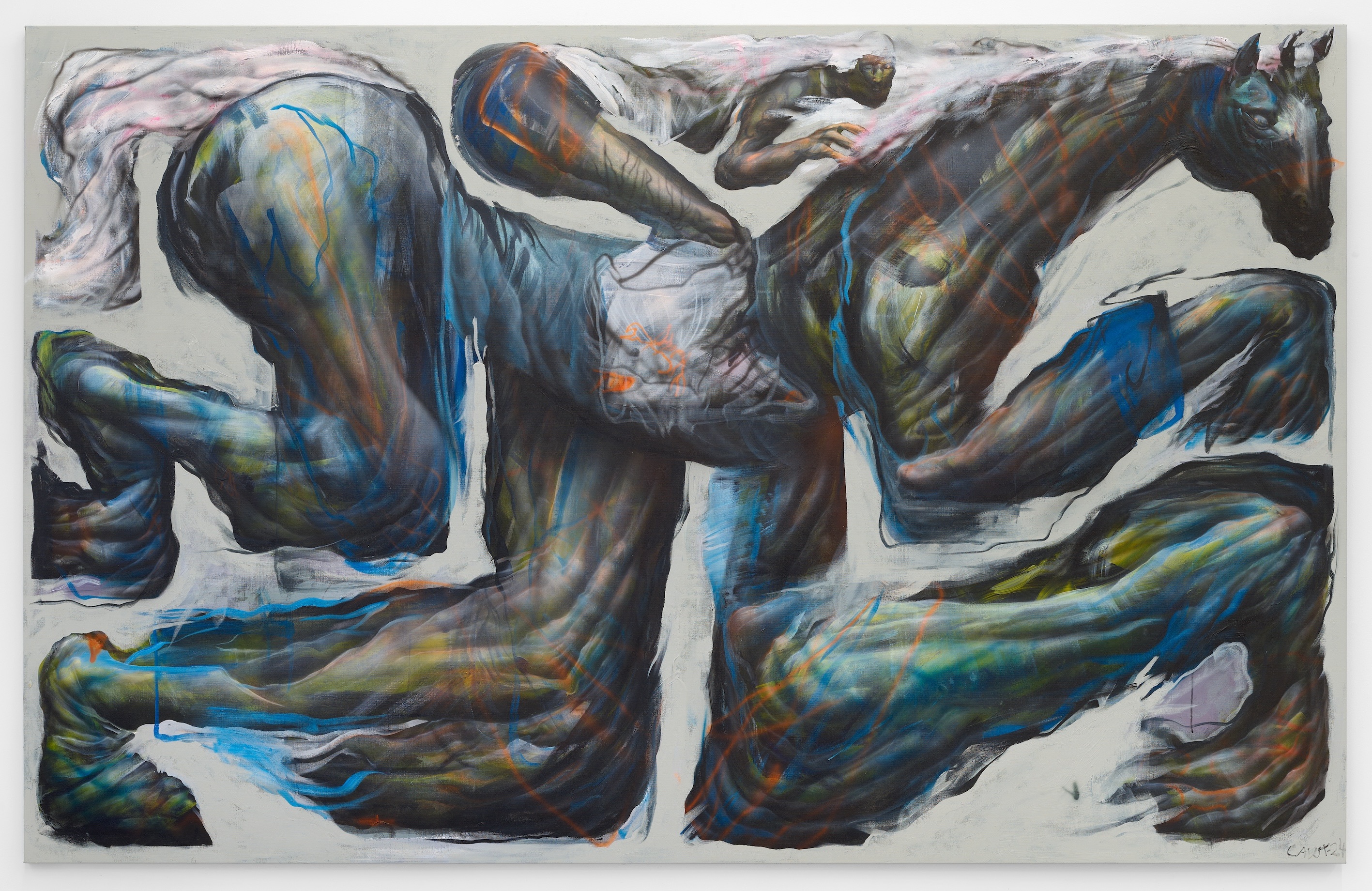
by Laust Højgaard
Chasing Menace
2024
Acrylic on linen
300 x 190 cm
Courtesy: the Artist & Galerie Droste
What is your artistic process like, how do you approach your painting?
I paint over a lot. Most of the works I paint won't make the cut. It's just like when it doesn't have the right expression in some way. It needs some sort of certain energy or mystery. If I feel like I lose pace or intuition I paint it all over and do it again and then suddenly it works. I keep my paintings away for some months before destroying them. Allowing them to convince me that they have something to offer. Because sometimes there's something in it that I like, but I just need to get rid of some other parts to balance it out. Either because they are too clean or too defined. If I define everything, then there's nothing to explore for me in the process. I want the viewer to explore for themselves too if it's one way or another, with facial expressions for example: is the person dreaming or dead? I don't want to define that for them. I think it's more like an expression and about the energy that I want people to see themselves in some way.
Often, I'm going to stop painting a work when it's like 70% done and start on something else and then come back to it. And then sometimes I have some weeks where I only finish stuff for a show or something. These pieces I work parallel on are not necessarily aligned visually but, yeah, still connected with each other. For instance when they have the same darkness or the same humor or something that kind of feels like it's a unit in some way. But it's always from the same kind of parallel universe that everything comes out of and it's something that has always been fascinating for me.
Wie sieht dein künstlerischer Prozess aus, wie gehst du an das Malen heran?
Ich male oft über vieles hinweg. Die meisten meiner Bilder gelingen nicht. Es ist, als hätten sie nicht den richtigen Ausdruck, irgendwie. Es braucht eine gewisse Energie oder ein gewisses Geheimnis. Manchmal, besonders bei den großen Bildern, komme ich an einen Punkt, an dem ich alles zu sehr definiere. Dann übermale ich vielleicht alles und mache es noch einmal, und dann funktioniert es. Ich behalte sie ein paar Monate, bevor ich sie zerstöre. Denn manchmal gefällt mir etwas daran, aber ich muss einfach ein paar andere Teile weglassen, um es irgendwie auszugleichen. Entweder weil sie zu sauber oder zu definiert sind. Wenn man alles definiert, gibt es nichts mehr zu erforschen. Und es muss nicht unbedingt wie etwas aussehen. Ich möchte nur, dass die Leute zweifeln, ob es so oder so ist, zum Beispiel durch Gesichtsausdrücke: Träumt die Person oder ist sie tot? Das will ich nicht festlegen. Ich denke, es ist mehr ein Ausdruck und eine Energie, die ich möchte, dass die Leute auf irgendeine Weise selbst erforschen.
Oft höre ich mit einem Bild auf, wenn es zu 70 Prozent fertig ist, und fange mit etwas anderem an, um dann wieder darauf zurückzukommen. Und manchmal habe ich Wochen, in denen ich nur Dinge für eine Ausstellung oder so fertigstelle. Diese Arbeiten, die parallel entstehen, sind visuell nicht unbedingt aufeinander abgestimmt, aber irgendwie miteinander verbunden. Zum Beispiel, wenn sie die gleiche Düsternis oder den gleichen Humor haben oder sich irgendwie wie eine Einheit anfühlen. Aber alles kommt immer aus der gleichen Art von Paralleluniversum, aus dem alles kommt, und das ist etwas, was ich schon immer mit Menschen und Kreaturen gemacht habe.
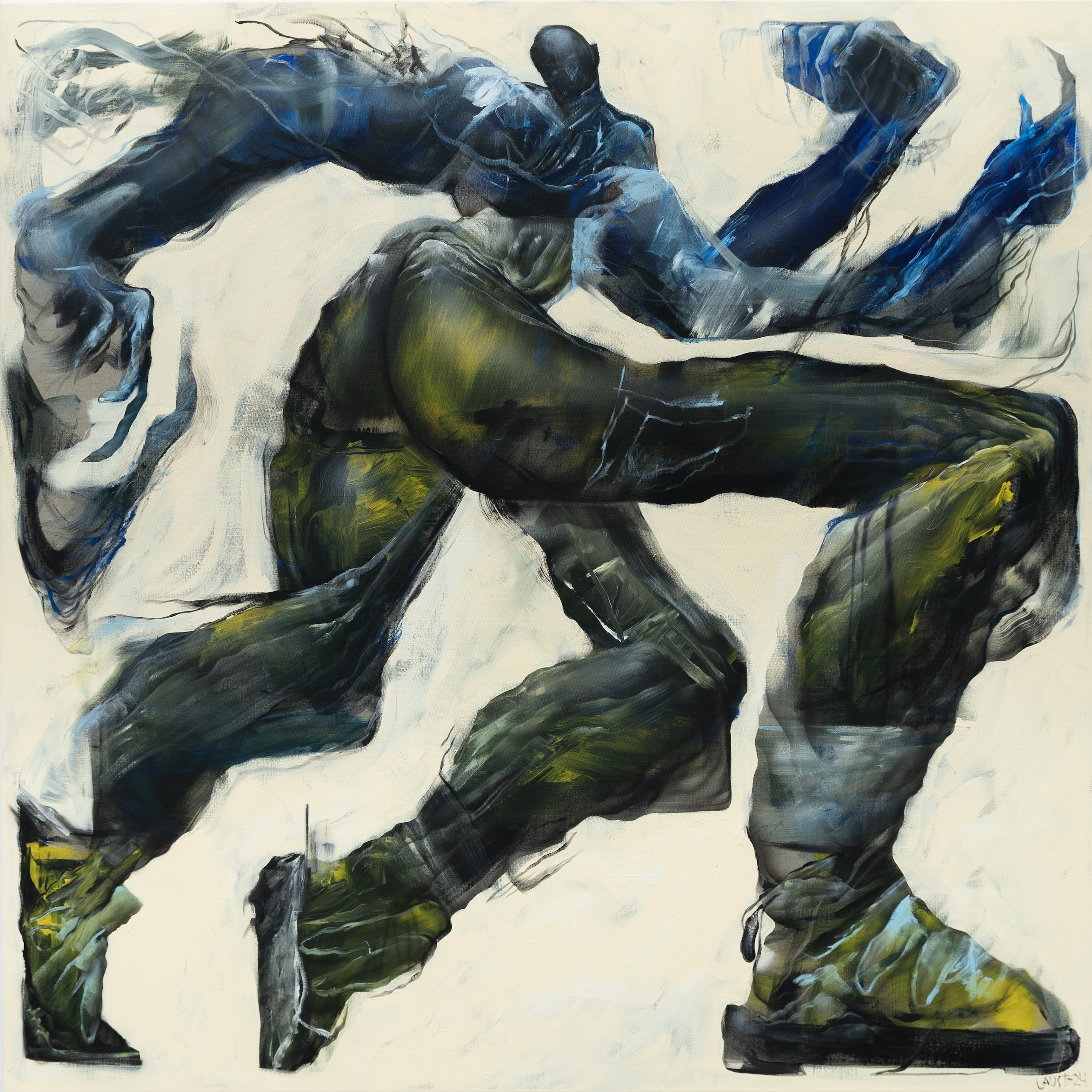
by Laust Højgaard
Protégée
2024
Acrylic on linen
195 x 195 cm
Courtesy: the Artist & Galerie Droste
I think “mysterious” is an excellent word to describe exactly this feeling that you approach the work as a viewer and you're like, what's happening? What do I feel? What does this painting want that I should feel? And it's not defined. It's never defined.
Yeah, totally. It needs to be an open discussion in some way, right? In the viewer's head in some way. At least that's where I want to be. I don't even know, it's not like I don't want to tell it's actually about this or that. For me it should be open as well. And I think if it's not open for me, then it's not possible to be open for other people either. I need to stay curious. That's my main goal always. I try to always steer away from falling into a classical sort of routine. Intuition is key.
Ich denke, " mysteriös" ist ein ausgezeichneter Begriff, um genau dieses Gefühl zu beschreiben, mit dem man als Betrachter an die Arbeit herangeht und denkt: Was passiert hier? Was fühle ich? Was will dieses Bild, dass ich fühle? Und das ist nicht festgelegt. Es ist nie festgelegt.
Ja, genau. Es muss in gewisser Weise eine offene Diskussion sein, oder? Zumindest will ich das. Ich meine, es ist ja nicht so, dass ich nicht sagen will, worum es geht. Für mich muss es offen sein. Und ich denke, wenn es für mich nicht offen ist, kann es auch für andere nicht offen sein. Ich muss neugierig bleiben. Das ist immer mein Hauptziel. Wenn ich zu sehr in Routine verfalle, wird es nie so, wie ich es geplant habe, weil ich versuche, es nicht zu planen. Denn wenn ich das tue, wird es starr und langweilig, und dann strebe ich etwas Bestimmtes an. Und dann ist es wieder uninteressant. Und noch einmal, das Interessante ist, dass es so viele verschiedene Arten von Elementen gibt.
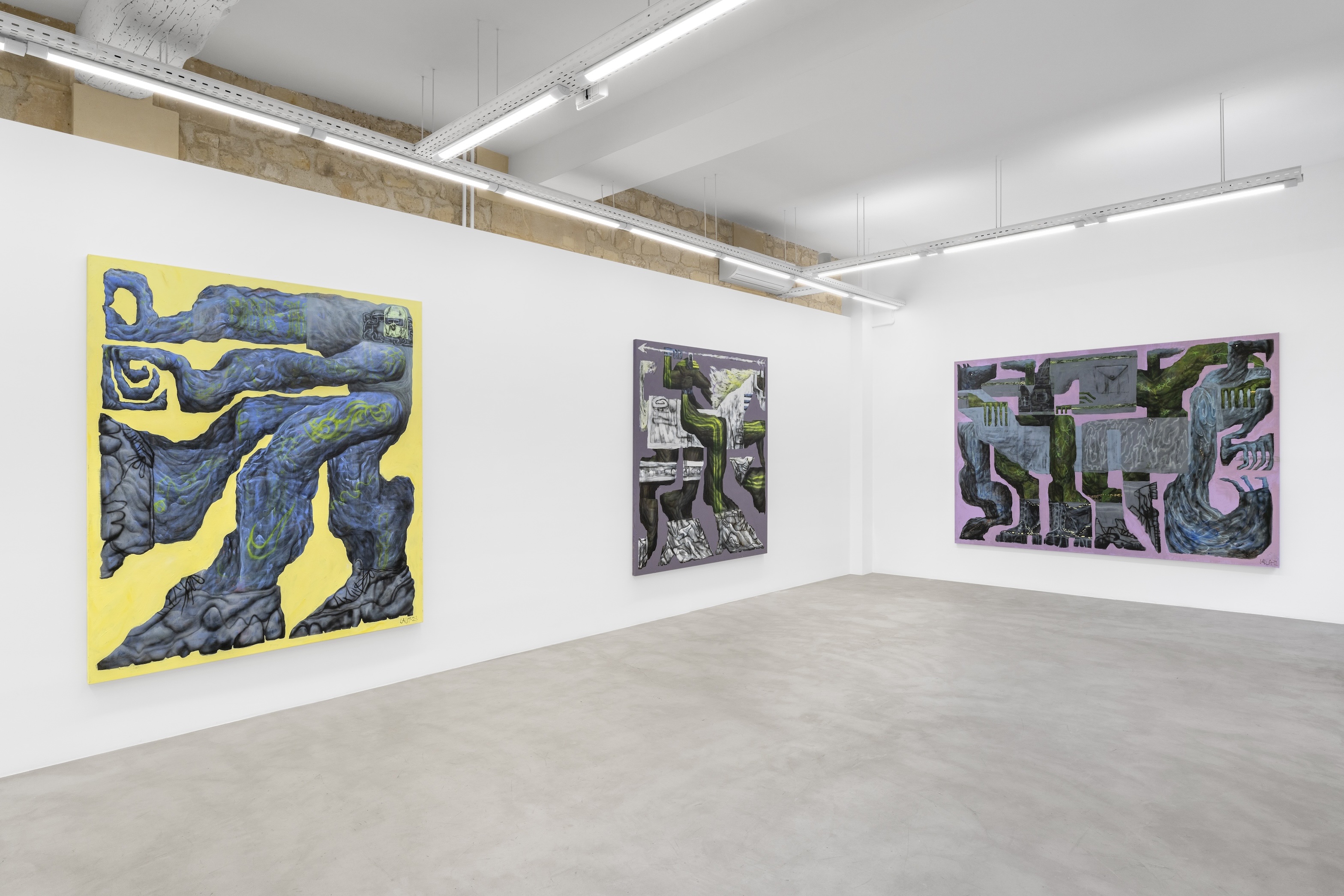
by Laust Højgaard
Exhibition view What We Did when the Sun Turned Green
Galerie Droste, Paris
2023
Did you learn this for yourself during the last years or was this a general approach that it was always for you? Like, “I can't work when I have this routine”. Or how was the process?
Yeah, it actually changed a lot because I think since I was a kid, I drew all the time. And when I got older and my friends got older, I just kept on drawing. And the thing was I got really fucking frustrated in the process always because I was so “perfectionistic”. At that point I was mainly drawing. I had to have a clean paper in front of me, have three sharp pencils and everything had to be perfect and almost like a “I need my eight hours of sleep” kind of feeling. Like I needed the best version of me to create something good. And then I always had a plan with what I wanted to end up with and it never happened. It just stopped me all the time for years. I think craft, a certain process and construction kind of interfered with my ideas. I didn't feel I was doing good enough. It wasn't beautiful enough. It wasn't perfect enough.
Hast du dir das in den letzten Jahren selbst beigebracht oder war das schon immer deine generelle Herangehensweise? Also "Ich kann nicht arbeiten, wenn ich diese Routine habe". Oder wie war der Prozess?
Ja, das hat sich wirklich sehr verändert, weil ich glaube, seit ich ein Kind war, habe ich die ganze Zeit gezeichnet. Und als ich älter wurde und meine Freunde älter wurden, habe ich einfach weiter gezeichnet. Und das Ding war, ich war immer total frustriert im Prozess, weil ich so "perfektionistisch" war. Damals habe ich hauptsächlich gezeichnet. Ich musste ein sauberes Blatt Papier vor mir haben, drei Stifte bereit halten und alles musste perfekt sein, fast so wie "Ich brauche meine acht Stunden Schlaf". Ich brauchte mein Bestes. Und dann hatte ich immer einen Plan, was ich am Ende haben wollte, und es ist nie passiert. Und das hat mich die ganze Zeit aufgehalten, jahrelang. Ich glaube, das Handwerk hat irgendwie meine Ideen gestört. Ich fühlte mich nicht gut genug. Es war nicht schön genug. Es war nicht perfekt genug.
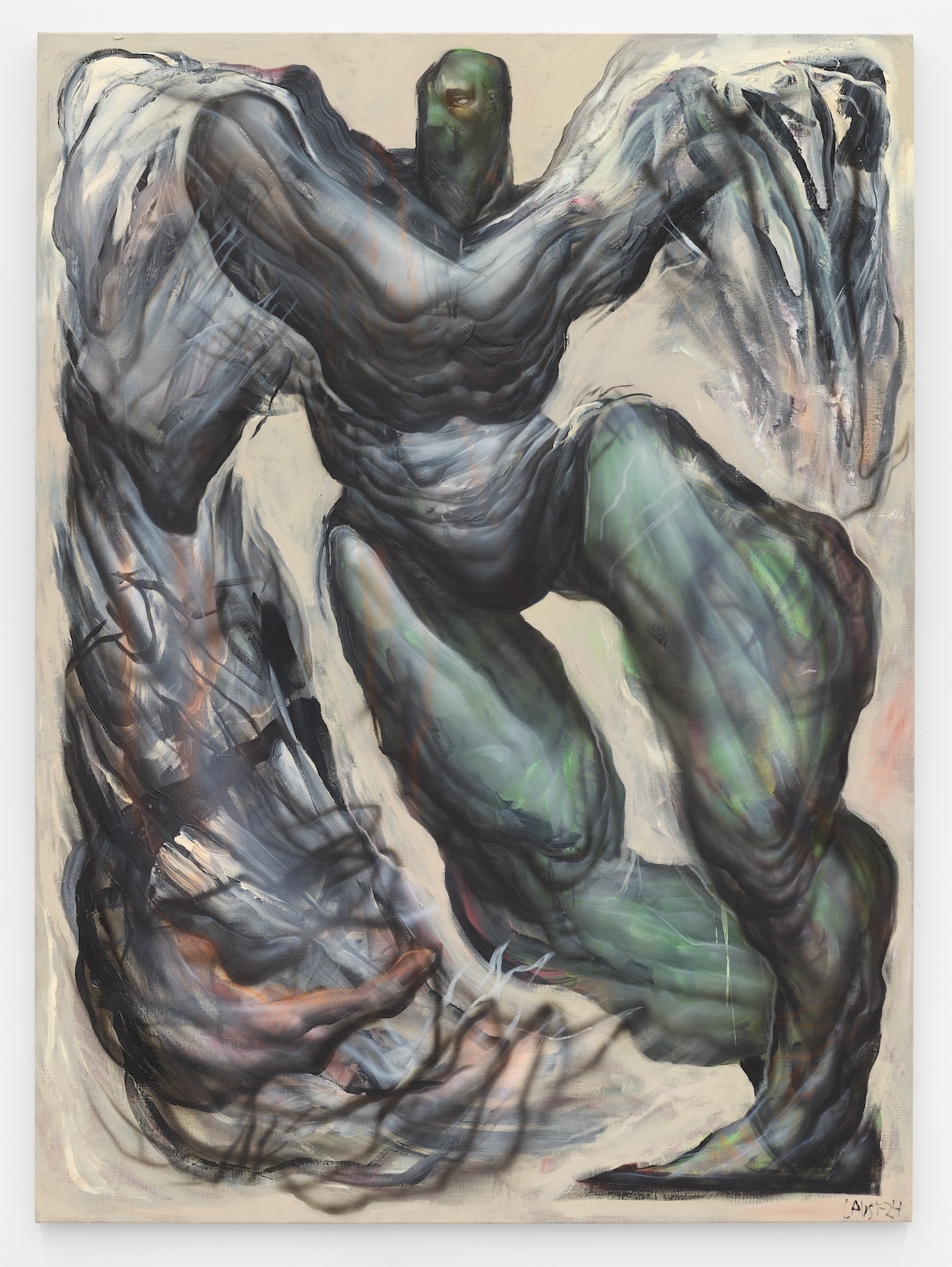
by Laust Højgaard
Ængel
2024
Acrylic on linen
190 x 140 cm
Courtesy: the Artist & Galerie Droste
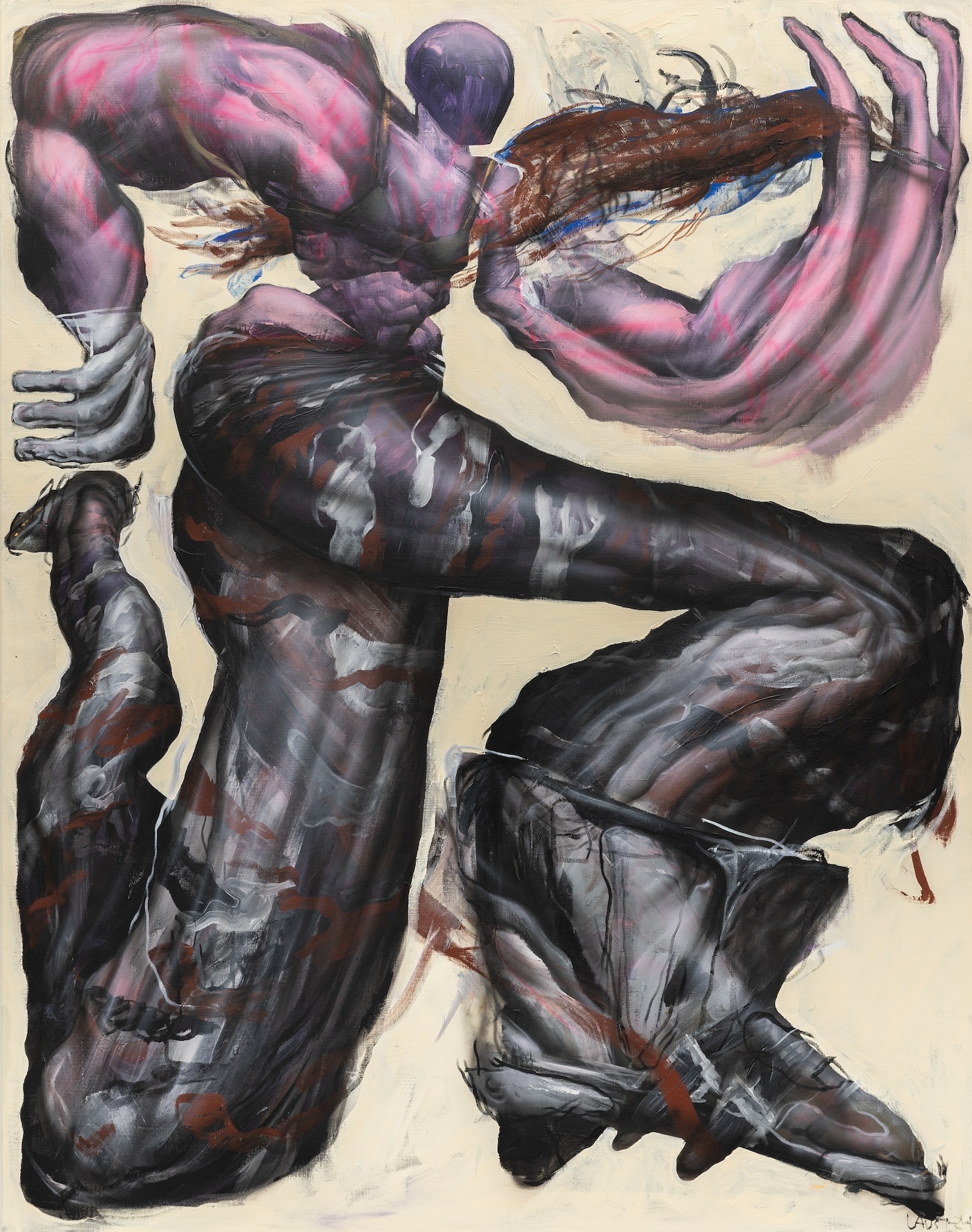
by Laust Højgaard
Admirer
2024
Acrylic on linen
190 x 150 cm
Courtesy: the Artist & Galerie Droste
This sounds really exhausting.
It was really exhausting. I've been working with classical drawing and 3D modeling and different stuff and I had a very like classical art education. I went to school, we were like 20 students or something and the aim was to have it all look the same. And I think probably many artists can relate. It's only craft. It needed to be perfection at the time. And it got boring and I got anxious because I wasn't curious anymore, I felt like I was doing math in some way, only constructing stuff. And then I actually stopped and didn't do it for almost 10 years. And my creativity was simply switched off. I used to play music and I didn't. I stopped listening to music. I stopped drawing, stopped painting and everything. And then I got into advertising and graphic design. I did film production and commercial stuff. And then I just broke down. I couldn't do it anymore. And then I got like really sick. And I got really fucking stressed and got an autoimmune liver disease and a bleeding disorder and everything was just fucked up and I had to stop working. I was numb. And then I was told that I needed to do a hardcore medicine treatment for the rest of my life with injections of all sorts of weird radiated stuff. And then, in the meantime, we moved here [to Thurø, Denmark, ed. note] and I started painting again and I did that for a while. And then the day before I needed to start on all these medicine stuff, they checked my blood and everything was just like gone. Like everything was good. So much frustration for so many years was gone. So it's just like, I need to paint and create stuff because this is what keeps me up. I need it to stay happy and healthy. And I found out that I needed to have fun with it. Like it's not about perfection. It's not like I want it to be pretty or beautiful. I need it to be interesting. And interesting for myself. And the good thing is I found out like, if it's really interesting for me, then apparently, it's interesting for other people as well, right? But it took many, many years and it's still a struggle in me to keep myself on the track, to explore new ways, always finding the spots where I am “Ah, okay, what if I did this and what if I did that” instead of thinking of the end result.
Das klingt anstrengend.
Es war wirklich anstrengend. Ich habe mit klassischem Zeichnen und 3D-Modellierung und verschiedenen Dingen gearbeitet und hatte eine sehr klassische künstlerische Ausbildung. Ich bin zur Schule gegangen, wir waren ungefähr 20 Schüler und das Ziel war, dass alles gleich aussieht. Und ich denke, dass wahrscheinlich viele Künstler diese Idee nachvollziehen können. Es ging nur um das Handwerk. Es musste Perfektion sein. Und es wurde langweilig und ich bekam Angst, weil ich nicht mehr neugierig war, ich hatte das Gefühl, ich würde irgendwie Mathematik machen, nur Dinge konstruieren. Und dann habe ich es tatsächlich fast 10 Jahre nicht mehr gemacht. Meine Kreativität war einfach ausgeschaltet. Früher habe ich Musik gemacht und dann nicht mehr. Ich habe aufgehört, Musik zu hören. Ich habe aufgehört zu zeichnen, zu malen und alles. Dann habe ich Werbung und Grafikdesign gemacht. Ich habe Videos gemacht und kommerzielle Sachen. Und dann bin ich einfach zusammengebrochen. Ich konnte nicht mehr. Und dann wurde ich richtig krank. Ich hatte richtig viel Stress und bekam eine Autoimmunerkrankung in der Leber und eine Blutungsstörung und alles war durcheinander und ich musste aufhören zu arbeiten. Und dann sagten sie mir, dass ich für den Rest meines Lebens Medikamente nehmen müsse und Spritzen mit allen möglichen komischen Sachen bekommen würde. Und dann zogen wir hierher [nach Svendborg, Dänemark, Anm. d. Verf.] und ich fing an zu malen. Und dann, einen Tag bevor ich mit den ganzen Medikamenten anfangen sollte, haben sie mein Blut untersucht und alles war weg. Alles war in Ordnung. Es ist, als ob ich malen muss, weil es das ist, was mich aufrecht hält. Und ich habe herausgefunden, dass es mir Spaß machen muss. Es geht nicht darum, perfekt zu sein. Es ist nicht so, dass ich es hübsch oder schön haben will. Ich muss interessant sein. Und interessant für mich selbst. Und das Gute ist, ich habe herausgefunden, wenn es für mich interessant ist, dann ist es anscheinend auch für andere interessant, oder? Aber es hat viele, viele Jahre gedauert, und es ist immer noch ein Kampf in mir, mich davon abzuhalten, neue Wege zu gehen, immer wieder die Stellen zu finden, an denen ich denke: "Ah, okay, was wäre, wenn ich das und das machen würde", anstatt an das Endergebnis zu denken.
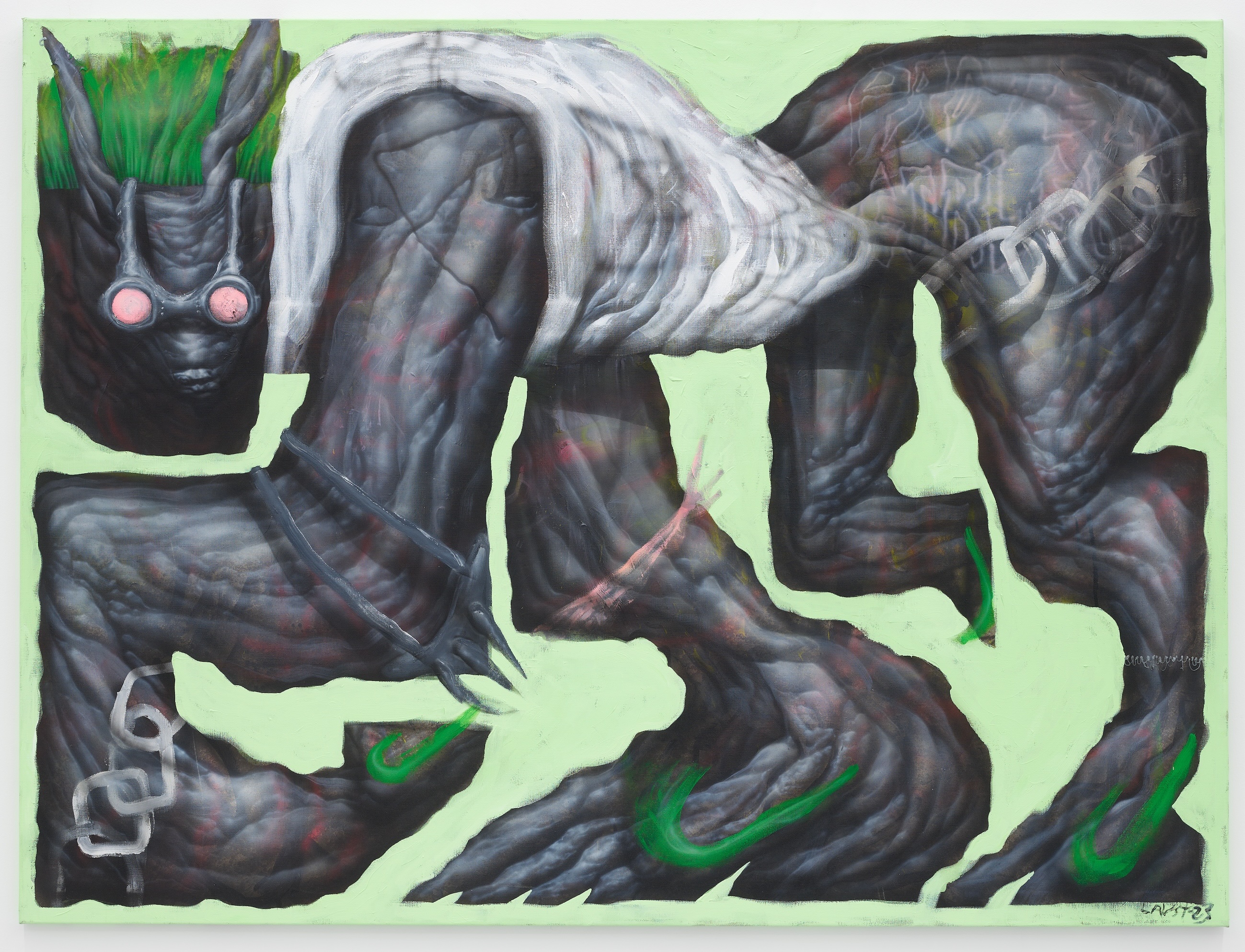
by Laust Højgaard
Riddick
2024
Acrylic on linen
200 x 150 cm
Courtesy: the Artist & Galerie Droste
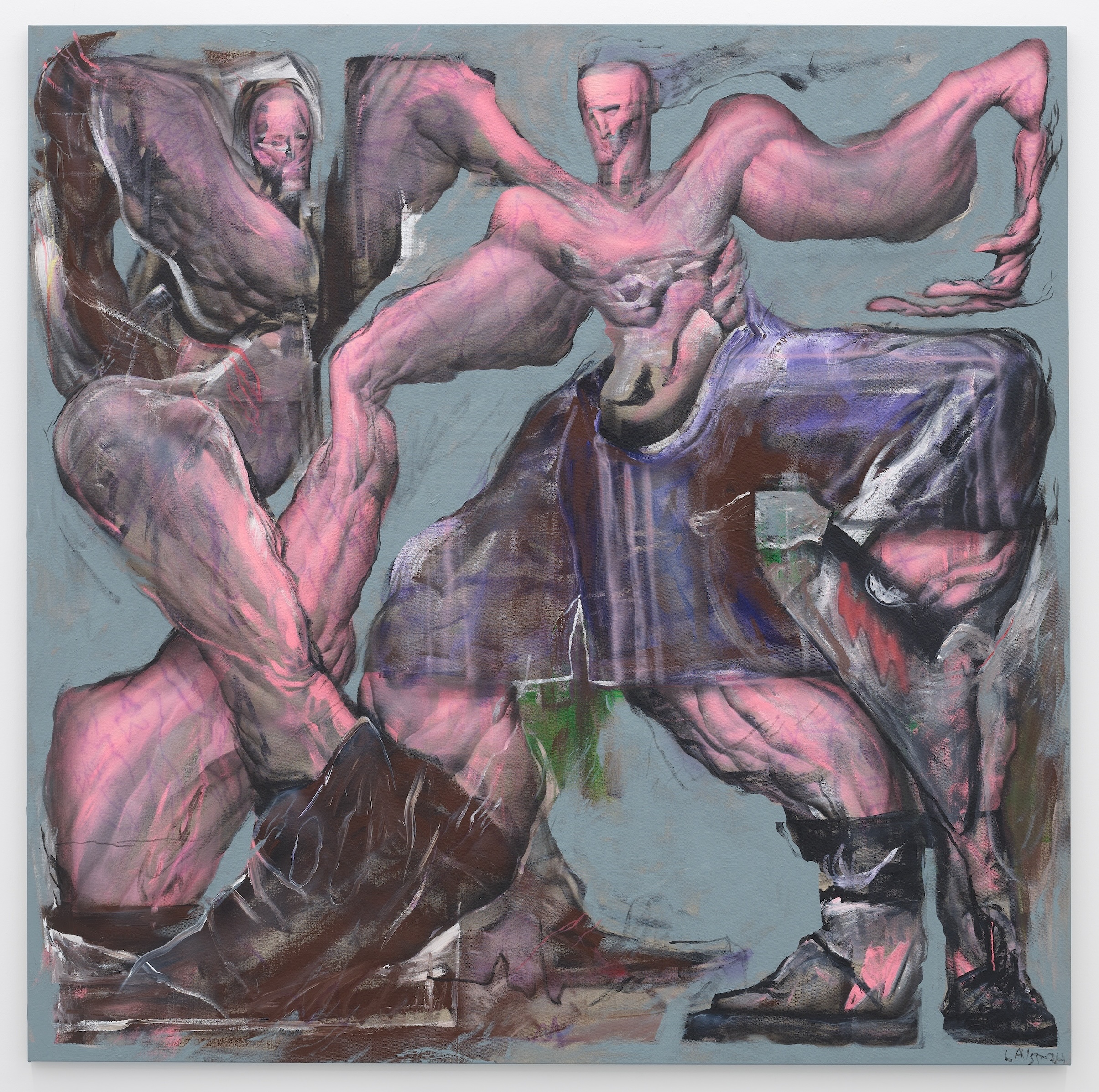
by Laust Højgaard
Transcendence
2024
Acrylic on linen
190 x 190 cm
Courtesy: the Artist & Galerie Droste
So you only started painting again three years ago?
Yeah 3-4 years ago. Then I started again. And then I actually started with this fake Instagram account. No one knew who I was and I just decided to put everything out there to avoid being judged in any way. It was fun. Like I did a weird drawing and I put it out. I did something completely different. I put it out, put it out, put it out and I did that for at least half a year where I didn't want to be conceptual or follow a red thread. I just needed an output. And then, yeah, then suddenly people started to be like interested in buying stuff and galleries started contacting me and then suddenly I kind of had to put my real name out there. But it was really essential to have this digital playground in the beginning.
Du hast also erst vor drei Jahren wieder angefangen zu malen?
Ja, dann habe ich wieder angefangen. Und dann habe ich eigentlich mit diesem falschen Instagram-Account angefangen. Niemand wusste, wer ich war, und ich entschied mich einfach, alles rauszuhauen. Ich habe eine komische Zeichnung gemacht und sie gepostet. Ich habe etwas ganz anderes gemacht. Ich habe es veröffentlicht, veröffentlicht, veröffentlicht, und das habe ich mindestens ein halbes Jahr lang gemacht, wo ich nicht konzeptionell sein wollte. Ich musste einfach Sachen rausbringen. Und dann, ja, dann fingen plötzlich Leute an, sich dafür zu interessieren, Sachen zu kaufen, und Galerien fingen an, mich zu kontaktieren, und dann musste ich plötzlich meinen richtigen Namen rausbringen. Aber es war wirklich schön, diesen digitalen Spielplatz zu haben.
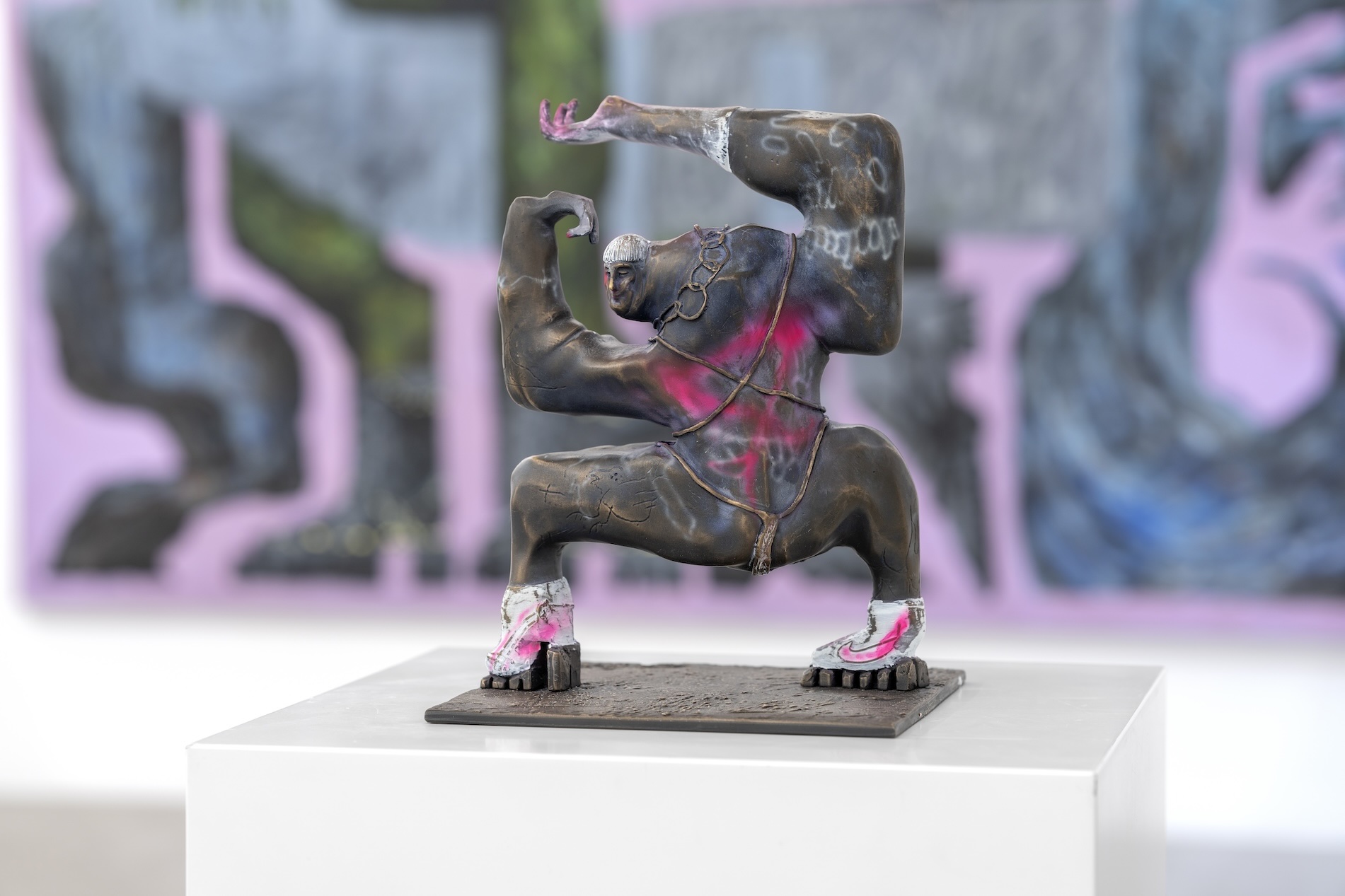
by Laust Højgaard
Exhibition view What We Did when the Sun Turned Green
Galerie Droste, Paris
2023
You told me earlier that you are not keen to define these themes, figures, universes, but if you had to – for an artist interview for example – how would you describe them?
For a long time I've been working with darkness and the contrast between darkness and happiness is definitely something that is always like fighting in my work. Visually I think there's like a spectrum of “clean” and “rough” and it needs both. There are certain things you can pull back and forth until the balance is right.
Also, I've always been fascinated about this whole post-apocalyptic thing and it's kind of like an excuse for me to do different colors of skin and backgrounds because the figures are in this weird, radiated universe where there’s no rules. I see my characters as these fragile giants that are affected by their surroundings. They are always really strong and heavy and feel like something from a quirky Greek mythology world. But I always want them to be inside themselves in some way. Mostly they have closed eyes. I want them to not be present. It's only kind of like their outer. It's their bodies that are present but they are pulled into themselves in some way. And that's also a thing that I think creates meaning for me. Again, are they sleeping or are they dead or are they sad … It's like they are protecting themselves in some way. Finally, I feel like it's not about where these figures are. They can be anywhere it doesn’t matter. I don't want to put them in a certain scene or put them into some sort of environment that pulls you away from their personality or their identity. It’s purely about them.
What I like about my big paintings are the brutality and the heavy majestically feeling the size creates. They become very powerful. I often find inspiration in old mythological paintings and statues and stuff like that. I like to create some sort of references but it's not like I follow one certain mythology only. But there's something in the poses that are so strong and makes them feel as ancient stoic giants. I try to put that power into my own universe and combine it with other elements. From there I concentrate more on it as organic shapes than on parts of a body: what if I connect this shape with this? And what if this is not a shape but it’s a shape defined of lines? And is it even a physical thing or is it sort of fragments moving? Am I looking at a surface or am I looking through it? That's what always interests me. And combining different tools, with the airbrush and brush and everything, it's like I borrow techniques from different worlds in some way. But as everything else it needs to be balanced just right.
Du hast mir vorhin gesagt, dass du diese Themen, Figuren, Universen nicht definieren willst, aber wenn du es müsstest – zum Beispiel in einem Künstlerinterview – wie würdest du sie beschreiben?
Ich arbeite schon lange mit Dunkelheit, und der Kontrast zwischen Dunkelheit und Humor ist definitiv etwas, das immer in meiner Arbeit kämpft. Visuell gibt es ein Spektrum von "sauber" und "rau", das ausbalanciert werden muss. Im Prozess geht es darum, ob ich es sehr grafisch oder sehr expressionistisch haben will. Es gibt bestimmte Dinge, die man hin und her schieben kann, bis man die richtige Balance gefunden hat. Beim Thema ist es wie mit Dunkelheit und Humor zum Beispiel, es gibt verschiedene Dinge, die man anpassen kann.
Und dann hat mich immer dieses ganze postapokalyptische Strahlungsthema fasziniert, und das ist für mich irgendwie eine Entschuldigung, verschiedene Hautfarben und Hintergründe zu machen, weil die Figuren in diesem seltsamen, verstrahlten Universum sind. Ich sehe sie als zerbrechliche Riesen. Sie sind immer sehr stark und schwer, wie in der griechischen Mythologie. Aber ich möchte immer, dass sie sich auf sich selbst beziehen. Meistens haben sie die Augen geschlossen. Ich will, dass sie nicht präsent sind. Es ist nur ihre Erscheinung. Ihre Körper sind präsent, aber sie ziehen sich irgendwie in sich selbst zurück. Und das ist auch etwas, was mir, glaube ich, die richtige Energie gibt. Schlafen sie oder sind sie tot oder sind sie traurig? Ich glaube, es gibt eine Schicht von dem, was in ihnen vorgeht, im Gegensatz zu dem, wie sie aussehen. Es ist, als würden sie sich irgendwie schützen. Letztendlich habe ich das Gefühl, dass es nicht darum geht, wo diese Figuren sind. Es geht um ihren Ausdruck. Ich möchte sie nicht auf eine Bühne stellen oder in eine Umgebung, die von ihrer Persönlichkeit oder Identität ablenkt.
Was mir an meinen großen Bildern gefällt, sind die Figuren. Sie werden sehr brutal. Ich schaue mir auch oft alte Gemälde an, oft griechische Mythologie und so. Ich stelle gerne einen Bezug her, aber es ist nicht so, dass ich eine bestimmte Figur aus der griechischen Mythologie male. Aber es gibt etwas in den Posen und einige starke Verweise darauf, die einen irgendwie dorthin führen, aber es ist mit einem anderen Universum verbunden. Ich habe angefangen, mich mehr auf die Formen als auf die Teile einer Person zu konzentrieren: Was ist, wenn ich diese Form mit jener verbinde? Was ist, wenn es keine Form ist, sondern eine Form, die durch Linien definiert ist? Und ist es überhaupt etwas Körperliches oder ist es Bewegung? Schaue ich auf eine Oberfläche oder durch sie hindurch? Das hat mich immer interessiert. Und verschiedene Werkzeuge zu kombinieren, mit der Airbrush und dem Pinsel und allem, das ist auch so, als ob man sich aus verschiedenen Welten bedient. Die Airbrush in meiner Arbeit definiert die Form, aber nicht zu sehr, sonst würde sie ihre Energie und Bewegung verlieren.
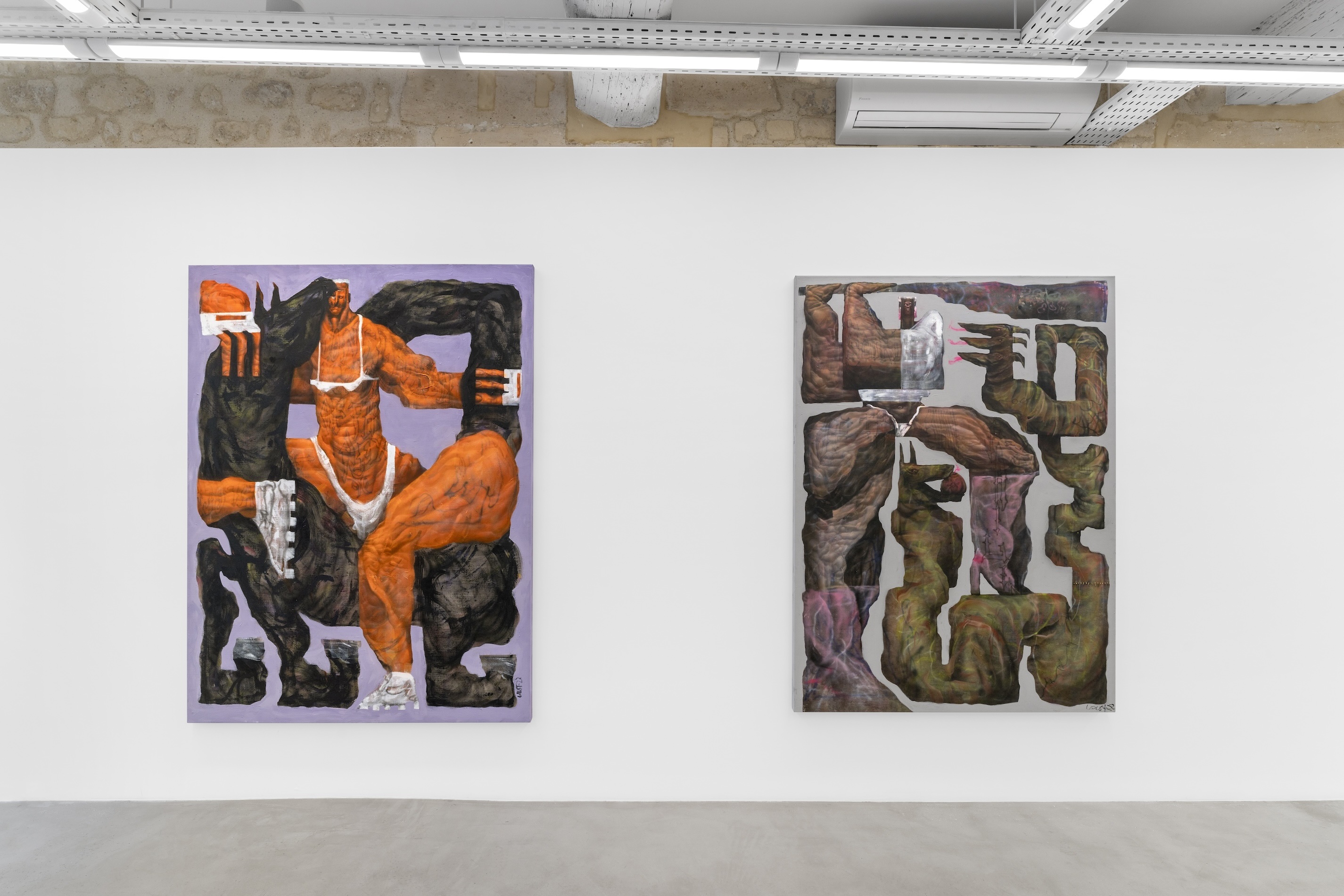
by Laust Højgaard
Exhibition view What We Did when the Sun Turned Green
Galerie Droste, Paris
2023
Where do you think you will be heading stylistically with your paintings as you continue to disrupt your routines?
Right now I'm probably more expressionistic in my work and I work more intuitively than I did earlier. In my process I often zigzag between abstract and clean and then return I would say. What works really well for me is exploring different nuances and corners of my style and after a while returning back to my foundation, bringing something new to the table that allows me to evolve.
Wohin, glaubst du, werden sich deine Bilder stilistisch entwickeln, wenn du deine Routine weiter durchbrichst?
Im Moment bin ich wahrscheinlich expressiver in meiner Arbeit und arbeite intuitiver und konstruiere nicht so viel und nehme auch Anleihen bei der Abstraktion und so weiter. Und dann gehe ich vielleicht zu etwas, das ein bisschen sauberer ist, und dann gehe ich wieder zurück und leihe von verschiedenen Orten und nehme das, was ich gelernt habe, und benutze es auf eine andere Art und Weise.
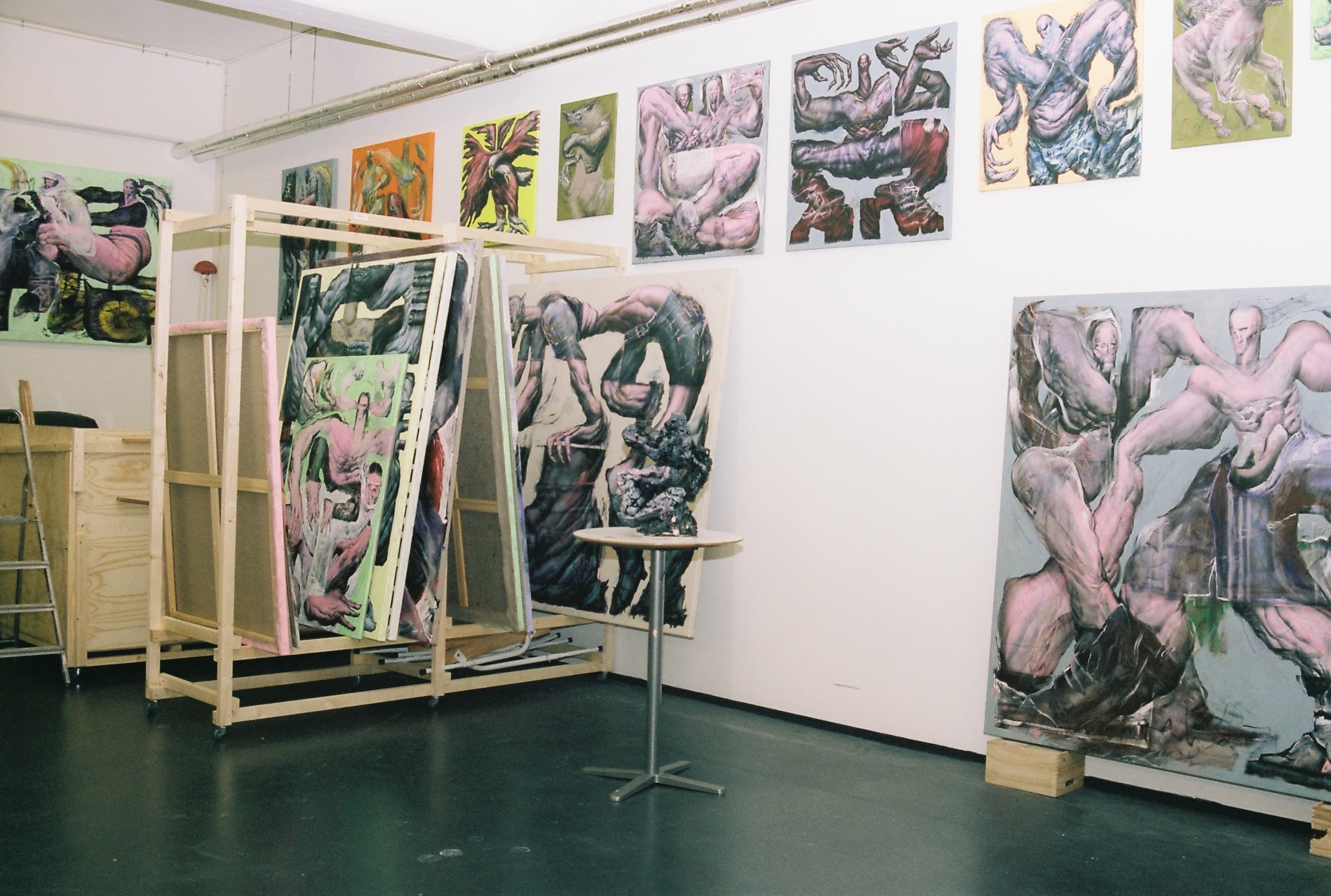
Photo: Luis Bortt

Photo: Luis Bortt
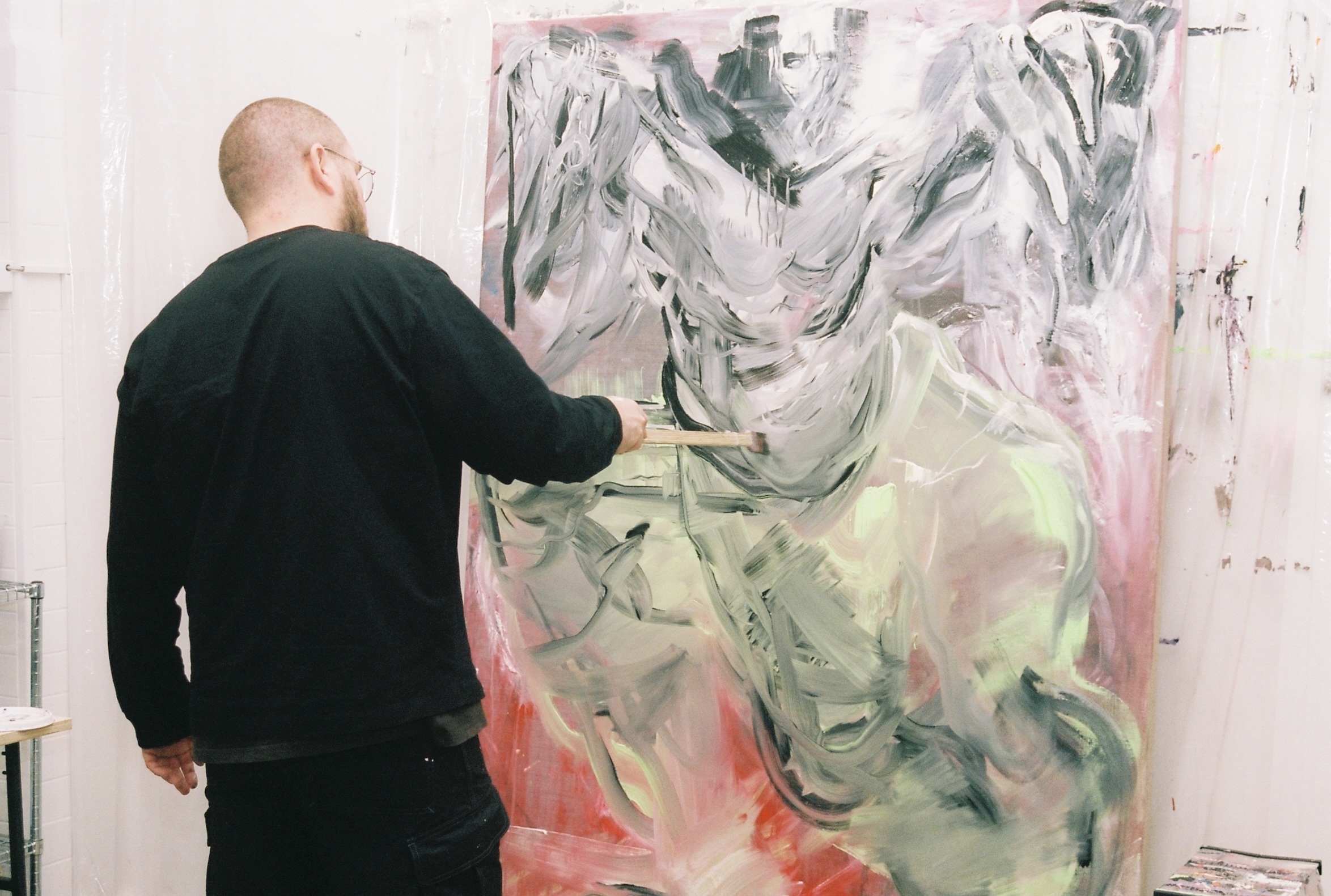
Photo: Luis Bortt
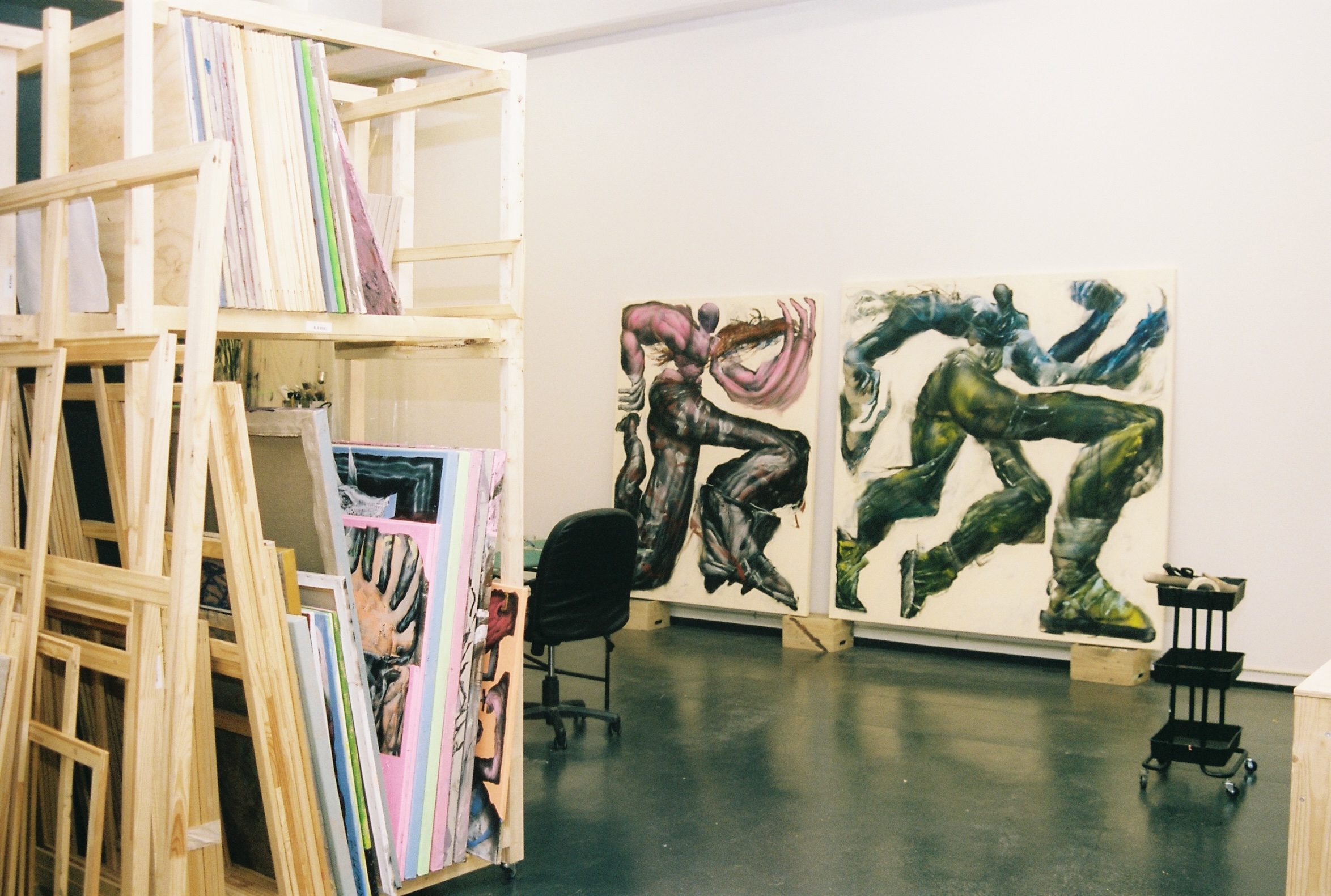
Photo: Luis Bortt

Photo: Luis Bortt
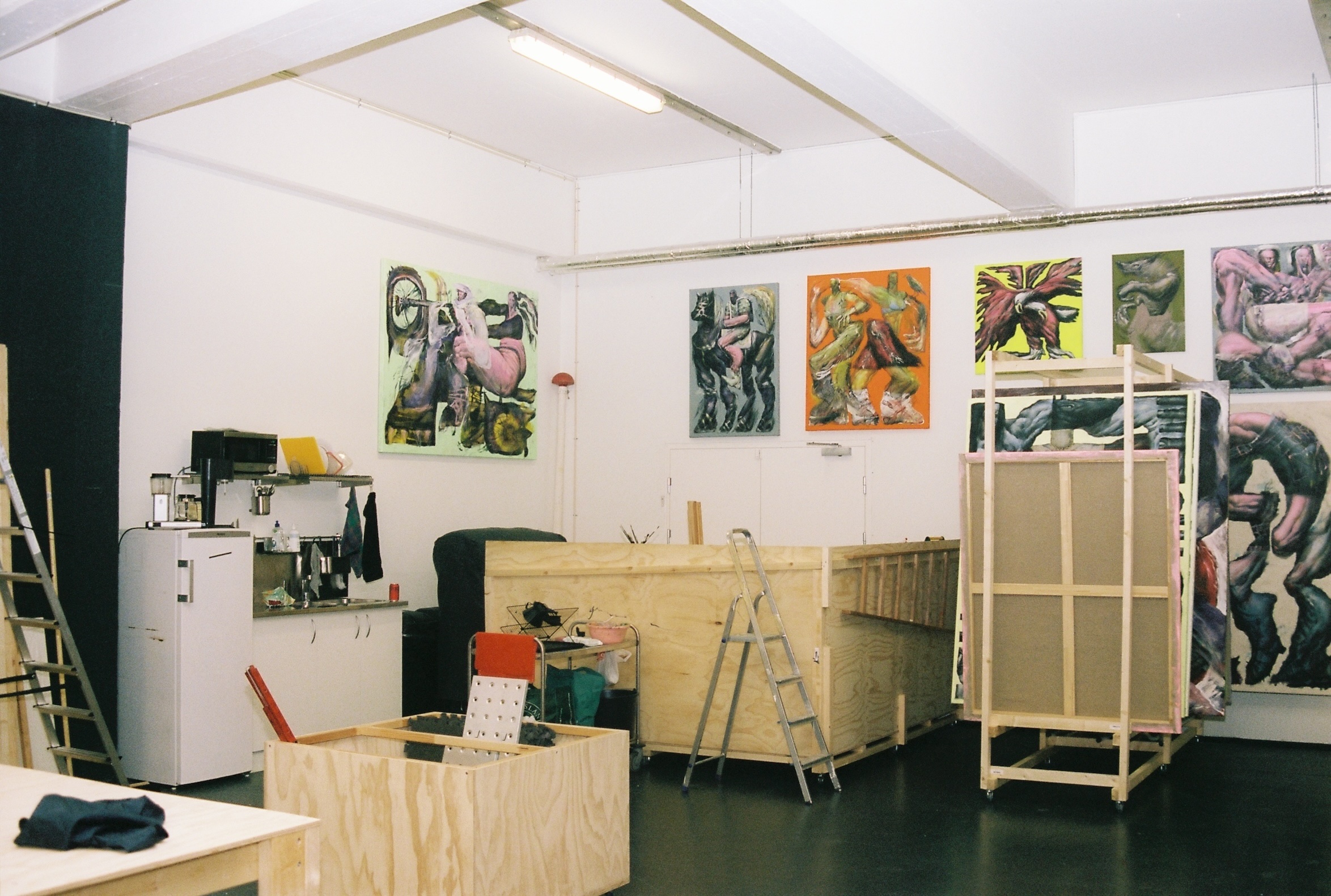
Photo: Luis Bortt
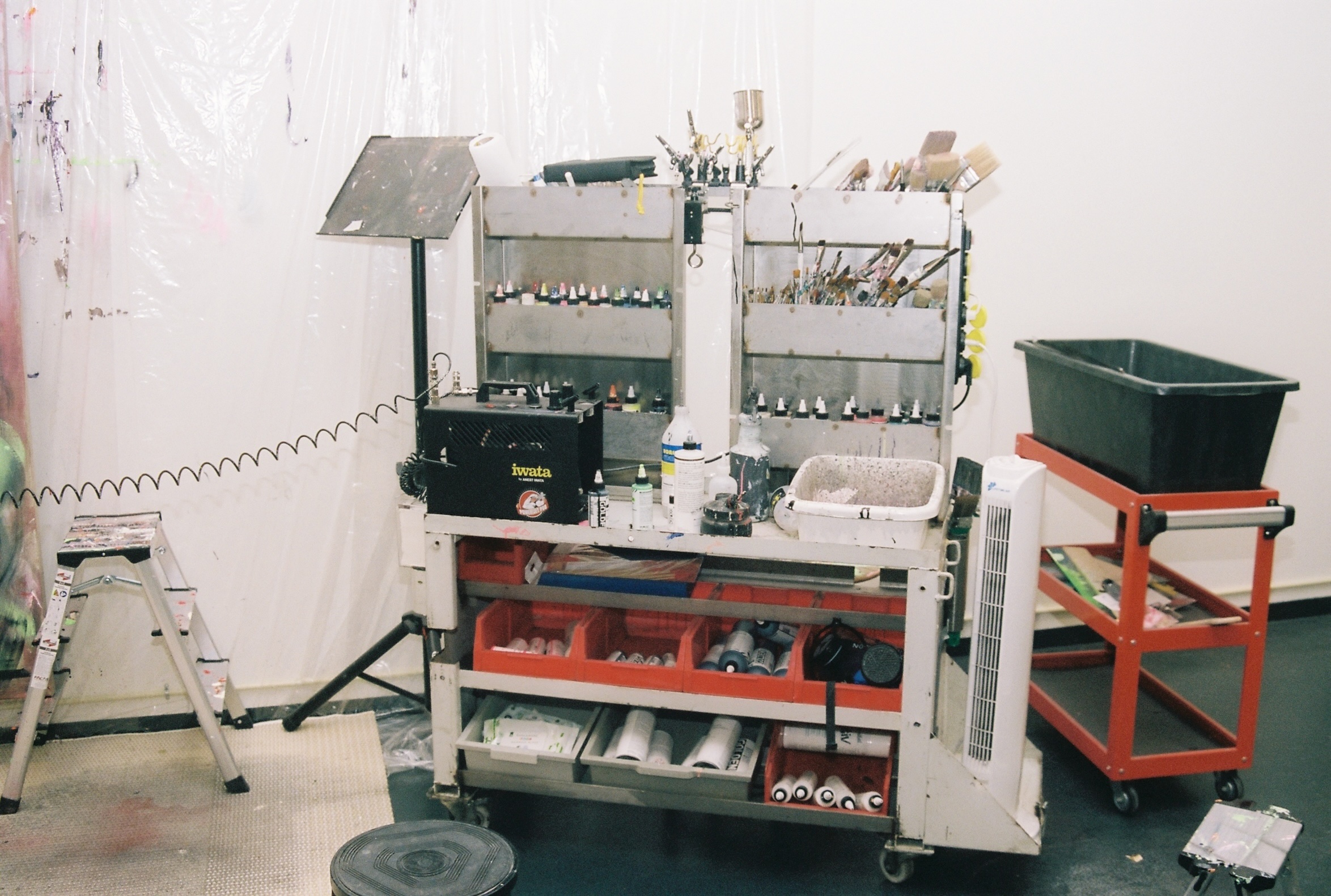
Photo: Luis Bortt
interview
Luis Bortt